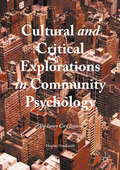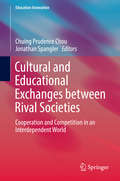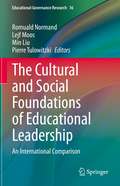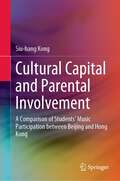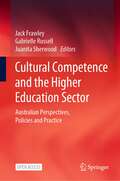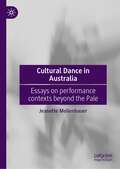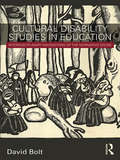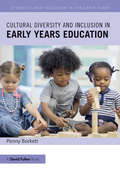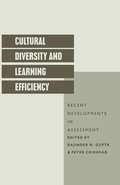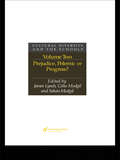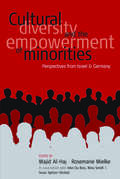- Table View
- List View
Cultural and Critical Explorations in Community Psychology: The Inner City Intern
by Heather MacdonaldThis book engages the practice of community-based psychology through a critical lens in order in order to demonstrate that clinical practice and psychological assessment in particular, require more affirmative psychopolitical agency in the face of racial injustice within the urban environment. Macdonald includes examples of clinical case analyses, vignettes and ethnographic descriptions while also drawing upon a cross-fertilization of theoretical ideas and disciplines. An oft neglected element of community psychology is the practice of community informed psychological assessment, especially within the inner city environments. This book uniquely suggests ideas for how clinical practice, in relationship to issues such as race and cultural memory can serve as a substantial vehicle for social justice against the backdrop of a prejudiced criminal justice system and mental health delivery system.
Cultural and Educational Exchanges between Rival Societies: Cooperation and Competition in an Interdependent World (Education Innovation Series)
by Chuing Prudence Chou Jonathan SpanglerThis book stimulates discussions on cultural and educational exchanges between rival states and societies, raises awareness of the potential positive and negative impacts of such exchanges, and serves as a basis for future research and program design. Cultural and educational exchanges in various forms have existed for millennia. Yet it was not until the unprecedented human devastation of two world wars catalyzed a sense of urgency around the world that a new era of cultural and educational exchange programs emerged as a means of easing tensions between rival states and societies. This book is motivated by the need for critical research that can contribute to building a more comprehensive understanding of the issues at stake. It begins with a historical overview of cultural and educational exchanges between rival societies, an assessment of their positive and negative impacts, and a review of some of the most prominent theories in relevant fields. It then presents a diverse set of case studies, in which authors consider not only the real or expected benefits of such exchanges but also the potentially negative impacts, challenges faced along the way, and broader effects on the rival societies at large. The states and societies considered include North Korea and the West, Bosnia and Herzegovina, Israel and the Palestinian territories, India and Pakistan, China and Taiwan, Cuba and the US, and China and the US. Taken together, the chapters demonstrate that exchanges have observable impacts on the individuals and institutions involved. Moreover, they reveal that exchanges have the capacity, in some cases, to affect broader social and political change at the family, community, society, or state level, but these impacts are indirect and typically require long-term concerted efforts by those involved.
Cultural and Linguistic Minorities in the Russian Federation and the European Union: Comparative Studies on Equality and Diversity (Multilingual Education #13)
by Heiko F. Marten Michael Rießler Janne Saarikivi Reetta ToivanenThis is the first comprehensive volume to compare the sociolinguistic situations of minorities in Russia and in Western Europe. As such, it provides insight into language policies, the ethnolinguistic vitality and the struggle for reversal of language shift, language revitalization and empowerment of minorities in Russia and the European Union. The volume shows that, even though largely unknown to a broader English-reading audience, the linguistic composition of Russia is by no means less diverse than multilingualism in the EU. It is therefore a valuable introduction into the historical backgrounds and current linguistic, social and legal affairs with regard to Russia’s manifold ethnic and linguistic minorities, mirrored on the discussion of recent issues in a number of well-known Western European minority situations.
Cultural and Social Diversity and the Transition from Education to Work (Technical and Vocational Education and Training: Issues, Concerns and Prospects #17)
by Guy TchibozoThis edited volume provides multidisciplinary and international insights into the policy, managerial and educational aspects of diverse students’ transitions from education to employment. As employers require increasing global competence on the part of those leaving education, this research asks whether increasing multiculturalism in developed societies, often seen as a challenge to their cohesion, is in fact a potential advantage in an evolving employment sector. This is a vital and under-researched field, and this new publication in Springer’s Technical and Vocational Education and Training series provides analysis both of theory and empirical data, submitted by researchers from nine nations including the USA, Oman, Malaysia, and countries in the European Union. The papers trace the origins of business demand for diversity in their workforce’s skill set, including national, local and institutional contexts. They also consider how social, demographic, cultural, religious and linguistic diversity inform the attitudes of those seeking work—and those seeking workers. With clear suggestions for future research, this work on a topic of rising profile will be read with interest by educators, policy makers, employers and careers advisors.
The Cultural and Social Foundations of Educational Leadership: An International Comparison (Educational Governance Research #16)
by Romuald Normand Lejf Moos Min Liu Pierre TulowitzkiThis book identifies the cultural and moral foundations of country-specific educational governance and school leadership and presents the principles of justice and the diversity of common goods that guide leadership practices in schools. It contributes to an existing research field that studies diversity and ethical leadership in schools. The social dimension of school leadership is not limited to issues related to equality and equity, or social inclusion. The capacity of leaders to promote civic-mindedness and social cooperation, consensus and acceptance of others, the right balance between freedom and duties, and reciprocity of obligations, are essential to maintain democratic rights and facilitate the life together while respecting ethnic and cultural differences. Therefore, the book gathers contributions from a range of international authors capable of reporting these moral and cultural features, while broadening the research perspectives on school leadership.
Cultural Awareness in Teaching Art and Design (Routledge Focus on Design Pedagogy)
by Kirsty MacariCultural Awareness in Teaching Art and Design addresses an emerging area of development in contemporary pedagogy, the fostering of cultural awareness and sensitivity in the designers of tomorrow.By offering new and unique examples of how to better educate students around issues of cultural awareness, this book presents teaching methodologies that ultimately facilitate students in becoming better, and more inclusive, art and design professionals. Today, the role of education in the addressing of social and cultural issues is increasingly seen as central to pedagogical methodologies. Through engaged teaching, experiential learning, socially orientated pedagogy or any other definition, the idea that students can and should be exposed to, and deal with, issues of importance to various stakeholders is increasingly seen as central to the teaching and learning experience – whether it be in relation to local communities, national economies, regional cultural identities or more. This is explored in a series of innovative, cross-disciplinary case studies in art and design teaching, with authors approaching questions of cultural awareness and engagement through the lenses of art history, product design, communication design, film, architecture and interior design. In presenting their pedagogical methodologies and case studies, the authors in this text offer a unique cross-disciplinary design perspective that captures the cultural and social concerns of several regions of the world: Europe, North America, Asia and Africa and the Middle East.This book will be essential reading for art and design educators and students interested in developing and applying models of cultural awareness and engagement in the classroom and studio.
Cultural Awareness in Teaching Art and Design (Routledge Focus on Design Pedagogy)
Cultural Awareness in Teaching Art and Design addresses an emerging area of development in contemporary pedagogy, the fostering of cultural awareness and sensitivity in the designers of tomorrow.By offering new and unique examples of how to better educate students around issues of cultural awareness, this book presents teaching methodologies that ultimately facilitate students in becoming better, and more inclusive, art and design professionals. Today, the role of education in the addressing of social and cultural issues is increasingly seen as central to pedagogical methodologies. Through engaged teaching, experiential learning, socially orientated pedagogy or any other definition, the idea that students can and should be exposed to, and deal with, issues of importance to various stakeholders is increasingly seen as central to the teaching and learning experience – whether it be in relation to local communities, national economies, regional cultural identities or more. This is explored in a series of innovative, cross-disciplinary case studies in art and design teaching, with authors approaching questions of cultural awareness and engagement through the lenses of art history, product design, communication design, film, architecture and interior design. In presenting their pedagogical methodologies and case studies, the authors in this text offer a unique cross-disciplinary design perspective that captures the cultural and social concerns of several regions of the world: Europe, North America, Asia and Africa and the Middle East.This book will be essential reading for art and design educators and students interested in developing and applying models of cultural awareness and engagement in the classroom and studio.
Cultural Capital and Parental Involvement: A Comparison of Students’ Music Participation between Beijing and Hong Kong
by Siu-hang KongThis book uses Pierre Bourdieu’s cultural capital model as a theoretical framework for exploring how students in Beijing and Hong Kong perceive parental influences—their parents’ cultural capital and support—on their participation in musical activities. By studying students’ perceptions of their parents’ cultural capital and support for their musical activities, this book revisits the applicability of Bourdieu’s cultural capital model in the contemporary Chinese context and reveals how inequality in terms of parental cultural capital governs parents’ support and influences the intergenerational transmission of cultural capital, which in turn contributes to inequality in terms of students’ cultural capital.
Cultural Competence and the Higher Education Sector: Australian Perspectives, Policies and Practice
by Jack Frawley Gabrielle Russell Juanita SherwoodThis open access book explores cultural competence in the higher education sector from multi-disciplinary and inter-disciplinary perspectives. It addresses cultural competence in terms of leadership and the role of the higher education sector in cultural competence policy and practice. Drawing on lessons learned, current research and emerging evidence, the book examines various innovative approaches and strategies that incorporate Indigenous knowledge and practices into the development and implementation of cultural competence, and considers the most effective approaches for supporting cultural competence in the higher education sector. This book will appeal to researchers, scholars, policy-makers, practitioners and general readers interested in cultural competence policy and practice.
Cultural Competence in Higher Education (Innovations in Higher Education Teaching and Learning #28)
by Tiffany Puckett Nancy S. LindIt is critical for professors to be able to teach students from a diversity of backgrounds and experiences to achieve success. This book provides an essential insight into teaching cultural competence in colleges and universities across the United States. Covering the experiences and challenges of instructors across disciplines, the chapters focus on the research, practices, narratives, and reflections related to preparing students to be culturally competent. Intended to address how to challenge systems that give power to only majority or privileged cultures, the purpose of this edited collection is to provide a vital resource through which readers can be equipped with the necessary knowledge related to teaching cultural competence. It provides a reference for instructors, researchers, and other stakeholders who are looking for material and strategies that will assist them in preparing students to become culturally competent.
Cultural Competence in Higher Education (Innovations in Higher Education Teaching and Learning #28)
by Tiffany Puckett, Nancy LindIt is critical for professors to be able to teach students from a diversity of backgrounds and experiences to achieve success. This book provides an essential insight into teaching cultural competence in colleges and universities across the United States. Covering the experiences and challenges of instructors across disciplines, the chapters focus on the research, practices, narratives, and reflections related to preparing students to be culturally competent. Intended to address how to challenge systems that give power to only majority or privileged cultures, the purpose of this edited collection is to provide a vital resource through which readers can be equipped with the necessary knowledge related to teaching cultural competence. It provides a reference for instructors, researchers, and other stakeholders who are looking for material and strategies that will assist them in preparing students to become culturally competent.
Cultural Conceptualizations in Translation and Language Applications (Second Language Learning and Teaching)
by Barbara Lewandowska-TomaszczykThe book comprises a selection of 14 papers concerning the general theme of cultural conceptualizations in communication and translation, as well as in various applications of language.Ten papers in first part Translation and Culture cover the topics of a cognitive approach to conceptualizations of Source Language – versus Target Language – texts in translation, derived from general language, media texts, and literature.The second part Applied Cultural Models comprises four papers discussing cultural conceptualizations of language in the educational context, particularly of Foreign Language Teaching, in online communication and communication in deaf communities.
Cultural Conflict & Adaptation
by Henry T. Trueba Lila Jacobs Elizabeth KirtonFirst published in 1990. Routledge is an imprint of Taylor & Francis, an informa company.
Cultural Conflict & Adaptation
by Henry T. Trueba Lila Jacobs Elizabeth KirtonFirst published in 1990. Routledge is an imprint of Taylor & Francis, an informa company.
Cultural Dance in Australia: Essays on performance contexts beyond the Pale
by Jeanette MollenhauerThis book draws on theories of aesthetics, post-colonialism, multiculturalism and transnationalism to explore salient aspects of perpetuating traditional dance customs in diaspora. It is the first book to present a broad-ranging analysis of cultural dance in Australia. Topics include adaptation of dance customs within a post-migration context, multicultural festivals, prominent performers, historiographies and archives, and the relative positionings of cultural and Western theatrical dance genres. The book offers a decolonized appraisal of dance in Australia, critiquing past and present praxes and offering suggestions for the future. Overall, it underscores the highly variegated nature of the Australian dance landscape and advocates for greater recognition of amateur community dance practices. Cultural Dance in Australia makes a substantial contribution to the catalogue of work about immigrants and cultural dance styles that continue to be preserved in Australia. This book will be of interest to scholars of dance, performance studies, migration studies and transnationalism.
Cultural Disability Studies in Education: Interdisciplinary Navigations of the Normative Divide (Routledge Advances in Disability Studies)
by David BoltOver the last few decades disability studies has emerged not only as a discipline in itself but also as a catalyst for cultural disability studies and Disability Studies in Education. In this book the three areas become united in a new field that recognises education as a discourse between tutors and students who explore representations of disability on the levels of everything from academic disciplines and knowledge to language and theory; from received understandings and social attitudes to narrative and characterisation. Moving from late nineteenth to early twenty-first-century representations, this book combines disability studies with aesthetics, film studies, Holocaust studies, gender studies, happiness studies, popular music studies, humour studies, and media studies. In so doing it encourages discussion around representations of disability in drama, novels, films, autobiography, short stories, music videos, sitcoms, and advertising campaigns. Discussions are underpinned by the tripartite model of disability and so disrupt one-dimensional representations. Cultural Disability Studies in Education encourages educators and students to engage with disability as an isolating, hurtful, and joyful experience that merits multiple levels of representation and offers true potential for a non-normative social aesthetic. It will be required reading for all scholars and students of disability studies, cultural disability studies, Disability Studies in Education, sociology, and cultural studies.
Cultural Disability Studies in Education: Interdisciplinary Navigations of the Normative Divide (Routledge Advances in Disability Studies)
by David BoltOver the last few decades disability studies has emerged not only as a discipline in itself but also as a catalyst for cultural disability studies and Disability Studies in Education. In this book the three areas become united in a new field that recognises education as a discourse between tutors and students who explore representations of disability on the levels of everything from academic disciplines and knowledge to language and theory; from received understandings and social attitudes to narrative and characterisation. Moving from late nineteenth to early twenty-first-century representations, this book combines disability studies with aesthetics, film studies, Holocaust studies, gender studies, happiness studies, popular music studies, humour studies, and media studies. In so doing it encourages discussion around representations of disability in drama, novels, films, autobiography, short stories, music videos, sitcoms, and advertising campaigns. Discussions are underpinned by the tripartite model of disability and so disrupt one-dimensional representations. Cultural Disability Studies in Education encourages educators and students to engage with disability as an isolating, hurtful, and joyful experience that merits multiple levels of representation and offers true potential for a non-normative social aesthetic. It will be required reading for all scholars and students of disability studies, cultural disability studies, Disability Studies in Education, sociology, and cultural studies.
Cultural Diversity and Education: Foundations, Curriculum, and Teaching
by James A. BanksNow available in paperback, the sixth edition of this definitive text provides students a strong background in the conceptual, theoretical, and philosophical issues in multicultural education from a leading authority and scholarly leader of the field---James A. Banks. In the opening chapter author Banks presents his well-known and widely used concept of Dimensions of Multicultural Education to help build an understanding of how the various components of multicultural education are interrelated. He then provides an overview on preparing students to function as effective citizens in a global world; discusses the dimensions, history, and goals of multicultural education; presents the conceptual, philosophical, and research issues related to education and diversity; examines the issues involved in curriculum and teaching; looks at gender equity, disability, giftedness, and language diversity; and focuses on intergroup relations and principles for teaching and learning.? ? This new edition incorporates new concepts, theories, research, and developments in the field of multicultural education and features: A new Chapter 5, "Increasing Student Academic Achievement: Paradigms and Explanations"?provides important explanations for the achievement gap and suggests ways that educators can work to close it. A new Chapter 7, "Researching Race, Culture, and Difference," explains the unique characteristics of multicultural research and how it differs from mainstream research in education and social science. A new Chapter 14, "Principles for Teaching and Learning in a Multicultural Society"?contains research-based guidelines for reforming teaching and the school in order to increase the academic achievement and social development of students from diverse racial, ethnic, cultural, language, and gender groups. A new Appendix—"Essential Principles Checklist"—designed to help educators determine the extent to which practices within their schools, colleges, and universities are consistent with the research-based findings described in the book.
Cultural Diversity and Education: Foundations, Curriculum, and Teaching
by James A. BanksNow available in paperback, the sixth edition of this definitive text provides students a strong background in the conceptual, theoretical, and philosophical issues in multicultural education from a leading authority and scholarly leader of the field---James A. Banks. In the opening chapter author Banks presents his well-known and widely used concept of Dimensions of Multicultural Education to help build an understanding of how the various components of multicultural education are interrelated. He then provides an overview on preparing students to function as effective citizens in a global world; discusses the dimensions, history, and goals of multicultural education; presents the conceptual, philosophical, and research issues related to education and diversity; examines the issues involved in curriculum and teaching; looks at gender equity, disability, giftedness, and language diversity; and focuses on intergroup relations and principles for teaching and learning.? ? This new edition incorporates new concepts, theories, research, and developments in the field of multicultural education and features: A new Chapter 5, "Increasing Student Academic Achievement: Paradigms and Explanations"?provides important explanations for the achievement gap and suggests ways that educators can work to close it. A new Chapter 7, "Researching Race, Culture, and Difference," explains the unique characteristics of multicultural research and how it differs from mainstream research in education and social science. A new Chapter 14, "Principles for Teaching and Learning in a Multicultural Society"?contains research-based guidelines for reforming teaching and the school in order to increase the academic achievement and social development of students from diverse racial, ethnic, cultural, language, and gender groups. A new Appendix—"Essential Principles Checklist"—designed to help educators determine the extent to which practices within their schools, colleges, and universities are consistent with the research-based findings described in the book.
Cultural Diversity and Inclusion in Early Years Education (Diversity and Inclusion in the Early Years)
by Penny BorkettCultural Diversity and Inclusion in Early Years Education reveals how cultural diversity can be celebrated in every early years setting. Acknowledging the impact of culture on a child’s development and identity, the book demonstrates the need for practitioners to appreciate cultural difference, value diversity and ensure inclusive practices. Alongside comprehensive discussion of current and historical policy relating to multiculturalism and relevant sociocultural theory, the book provides practical guidance and resources to support practitioners in responding to the challenges of working with families and children from diverse cultural backgrounds. Chapters focus on topics such as: policy and the role of the practitioner sociocultural theories relating to child development building working relationships with families the impact of culture on a child's identity enabling environments and inclusive strategies. Including case studies, reflective questions and suggestions for further reading and research, this essential book will help early years practitioners and students to embrace the varied cultural heritages of the children in their care.
Cultural Diversity and Inclusion in Early Years Education (Diversity and Inclusion in the Early Years)
by Penny BorkettCultural Diversity and Inclusion in Early Years Education reveals how cultural diversity can be celebrated in every early years setting. Acknowledging the impact of culture on a child’s development and identity, the book demonstrates the need for practitioners to appreciate cultural difference, value diversity and ensure inclusive practices. Alongside comprehensive discussion of current and historical policy relating to multiculturalism and relevant sociocultural theory, the book provides practical guidance and resources to support practitioners in responding to the challenges of working with families and children from diverse cultural backgrounds. Chapters focus on topics such as: policy and the role of the practitioner sociocultural theories relating to child development building working relationships with families the impact of culture on a child's identity enabling environments and inclusive strategies. Including case studies, reflective questions and suggestions for further reading and research, this essential book will help early years practitioners and students to embrace the varied cultural heritages of the children in their care.
Cultural Diversity And Learning Efficiency: Recent Developments In Assessment (pdf)
by Peter Coxhead Rajinder M GuptaCultural Diversity And The Schools: Volume 2: Prejudice, Polemic Or Progress?
by James Lynch Celia Modgil Sohan ModgilFirst published in 1992. Routledge is an imprint of Taylor & Francis, an informa company.
Cultural Diversity And The Schools: Volume 2: Prejudice, Polemic Or Progress?
by James Lynch Celia Modgil Sohan ModgilFirst published in 1992. Routledge is an imprint of Taylor & Francis, an informa company.
Cultural Diversity and the Empowerment of Minorities: Perspectives from Israel and Germany
by Rosemarie Mielke Majid Al-HajConflicts between different racial, ethnic, national and other social groups are becoming more and more salient. One of the main sources of these internal conflicts is social and economic inequality, in particular the increasing disparities between majority and minority groups. Even societies that had been successful in dealing with external conflicts and making the transition from war to peace have realized that this does not automatically resolve internal conflicts. On the contrary, the resolution of external conflicts may even sharpen the internal ones. This volume, a joint publication of the University of Haifa and the International Center for Graduate Studies (ICGS) at the University of Hamburg, addresses questions of how to deal with internal issues of social inequality and cultural diversity and, at the same time, how to build a shared civility among their different national, ethnic, religious and social groups.
